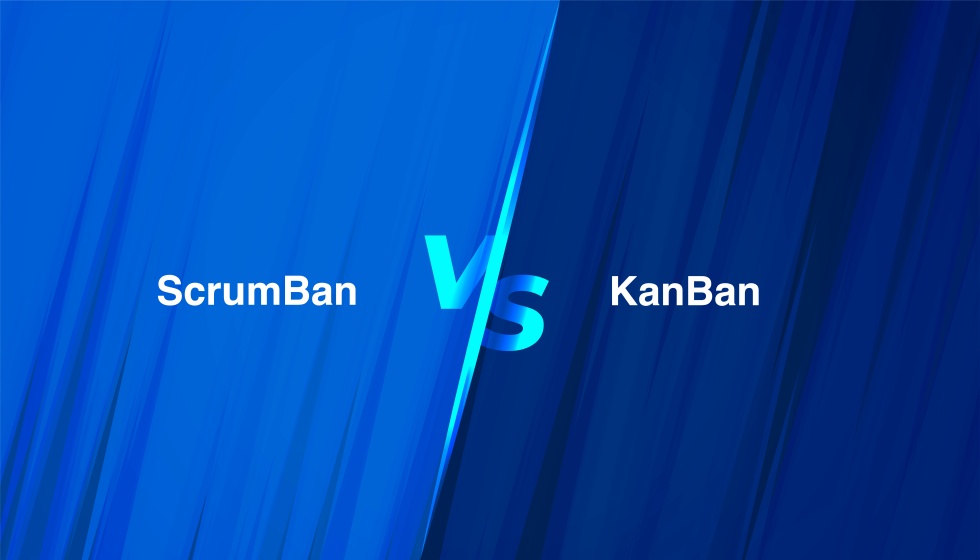Selecting the right framework can make all the difference when optimizing your product development process. In the fast-paced software development and project management world, methodologies like ScrumBan and Kanban have emerged as powerful tools. Both offer unique approaches to streamline workflows, enhance team collaboration, and ultimately, drive better results.
In this comprehensive comparison, we delve into the nuances of ScrumBan and Kanban, exploring their origins, core principles, and suitability for different project scenarios. By understanding each framework’s key differentiators and benefits, you’ll be better equipped to make an informed decision for your specific product development needs. Whether you’re seeking the structure of ScrumBan or the flexibility of Kanban, join us as we dissect these methodologies and guide you toward choosing the one that aligns perfectly with your team’s goals and challenges.
KanBan vs ScrumBan: Introduction
Searching for efficient and effective methodologies has given rise to various approaches in the ever-evolving landscape of software development and project management. Among these, ScrumBan and Kanban have emerged as prominent players, each offering a unique blend of agile principles tailored to the demands of modern product and software development teams.
As organizations strive for increased productivity, faster time-to-market, and the ability to swiftly adapt to changes, selecting the right methodology becomes paramount. This article sheds light on the distinct characteristics, strengths, and considerations of ScrumBan and Kanban, empowering decision-makers to make informed choices that align with their project goals.
ScrumBan is a hybrid agile methodology that draws from the well-structured framework of Scrum and the adaptive nature of Kanban. It combines time-bound iterations with continuous flow, providing teams with the predictability of Scrum while allowing for dynamic adjustments as per Kanban’s principles. On the other hand, Kanban emphasizes visualizing workflows, limiting work in progress, and promoting a culture of continuous improvement. Its focus on flexibility suits environments where requirements are subject to frequent changes.
ScrumBan vs KanBan: Comparing Key Features
Let’s compare ScrumBan, and KanBan features first.
Workflow Visualization and Management
Efficient project management hinges on the ability to visualize and manage workflows effectively. This entails clearly and transparently representing tasks’ progress through various stages. With workflow visualization, teams can identify bottlenecks, optimize processes, and ensure tasks move seamlessly from start to finish. This visual representation, often in Kanban boards or task-tracking systems, fosters a shared understanding among team members and stakeholders, reducing miscommunication and enhancing collaboration.
Managing workflows involves monitoring the status of tasks, adjusting priorities, and reallocating resources when necessary. Teams using Kanban enjoy real-time insights into task movement, enabling swift decision-making and promoting a steady workflow. ScrumBan, on the other hand, incorporates regular check-ins during sprints, allowing teams to adjust priorities and ensure alignment with project goals. Both methodologies offer approaches to streamline workflow management, catering to different project needs and preferences.
Work Item Prioritization and Planning
Prioritizing work items is a cornerstone of effective project management, ensuring that the most valuable tasks are tackled first. In ScrumBan, teams benefit from the iterative planning of Scrum combined with the flexibility of Kanban. Work items are assigned priority during sprint planning, but adjustments can be made mid-sprint, accommodating changing requirements.
Kanban emphasizes continuous reprioritization based on real-time demand. Work items are pulled into the workflow according to capacity and priority, allowing teams to focus on tasks that deliver immediate value. This approach is especially advantageous for complex projects with rapidly shifting priorities.
While ScrumBan’s structured approach provides predictability, Kanban’s adaptable prioritization promotes responsiveness. Choosing between them depends on the project’s nature, allowing teams to balance structured planning and dynamic reordering.
Iterative vs Continuous Delivery
The choice between iterative and continuous delivery methodologies significantly impacts how work is delivered and refined throughout a project’s lifecycle. Iterative delivery, as seen in ScrumBan, breaks projects into manageable sprints. This enables teams to deliver increments of work regularly, facilitating stakeholder feedback and fostering a sense of accomplishment.
At the heart of Kanban, continuous delivery centers on delivering value as soon as it’s ready. Unlike ScrumBan’s predefined sprint durations, Kanban allows immediate releases based on task completion. This approach is well-suited for projects with rapidly changing requirements or when frequent, small releases are advantageous.
Each methodology offers unique benefits to chief product owners (CPOs) and their teams. Iterative delivery provides stakeholders with regular updates and the opportunity to influence project direction, while continuous delivery responds swiftly to market demands. The choice depends on the project’s nature and the level of predictability desired.
Role Definitions and Team Dynamics
Successful project execution relies on well-defined roles and harmonious team dynamics. In ScrumBan, roles from Scrum and Kanban harmonize to ensure efficient collaboration. Scrum roles like Scrum Master, Product Owner, and Development Team members interact with the Kanban team’s focus on workflow optimization and continuous improvement.
Kanban emphasizes cross-functional collaboration without rigid role definitions. This approach promotes collective ownership and encourages team members to contribute across various tasks. ScrumBan, with its adaptable roles, offers a middle ground for teams transitioning from Scrum to Kanban teams.
Effective team dynamics are fueled by open communication and shared ownership. ScrumBan’s ceremonies foster structured interactions, while Kanban’s flexibility promotes ongoing collaboration. The choice depends on the other team member’s maturity and ability to balance roles and responsibilities effectively.
Do you need help implementing ScrumBan or KanBan?
Contact Growth Hackers
Time-Boxed Sprints vs Continuous Flow
Project management methodologies diverge in their approach to time-bound work cycles. ScrumBan employs time-boxed sprints, ensuring a fixed duration for each iteration. This predictability aids in planning and facilitates iterative development, allowing teams to review and adapt their approach at the end of each sprint.
Conversely, Kanban operates on a continuous flow model, allowing work items to progress at their own pace. This dynamic approach is particularly beneficial for projects with fluctuating priorities and unpredictable workloads.
The choice between time-boxed sprints and continuous flow depends on the project’s demands. Time-boxed sprints provide structured milestones, while continuous flow prioritizes flexibility and adaptability. Selecting the right model hinges on the project’s rhythm and the team’s ability to manage workloads effectively.
Adaptability to Change
Adaptability to change is a cornerstone of Agile methodologies. ScrumBan and Kanban offer distinct approaches to managing change while maintaining productivity.
ScrumBan allows mid-sprint changes, accommodating evolving requirements. Teams can adjust priorities or add new tasks, enhancing responsiveness. This is especially valuable when unexpected opportunities or challenges arise.
Kanban’s inherent flexibility also supports adaptability. Tasks can be added, removed, or reprioritized at anytime, enabling teams to pivot swiftly. This approach is suitable for projects where requirements are subject to rapid change.
Both methodologies promote agility, but the choice hinges on the extent of flexibility required. ScrumBan is ideal when change occurs within sprints, while Kanban excels in environments where constant adjustments are the norm.
Metrics for Progress Tracking
Accurate progress tracking is essential for informed decision-making. ScrumBan and Kanban offer distinct metrics to measure project advancement.
ScrumBan relies on Scrum’s velocity, indicating the work completed during a sprint. This metric aids in the sprint backlog, predicting future progress and identifying potential roadblocks.
On the other hand, Kanban focuses on cycle time—the time taken for a task to move from start to finish. This metric provides insights into workflow efficiency and helps identify areas for improvement.
Choosing the right metric depends on the project’s nature and goals. Velocity is valuable for predicting outcomes, while cycle time emphasizes workflow optimization. Careful consideration will guide the selection of the most relevant metric. This is when integrating project management tools can do wonders for your business’ productivity and efficiency.
Handling Uncertainty and Dependencies
Projects often contend with uncertainty and dependencies that impact progress. ScrumBan and Kanban provide strategies to manage these challenges effectively.
ScrumBan mitigates uncertainty through structured sprints, allowing teams to review and adjust their approach regularly. Dependencies are managed by prioritizing tasks and coordinating efforts during sprint planning.
Kanban excels in handling uncertainty by adapting the production process to real-time changing demands. Dependencies are managed by visualizing task movement and optimizing workflow stages.
Balancing Structure and Flexibility
Striking the right balance between structure and flexibility is vital for project success. ScrumBan and Kanban offer distinct approaches to finding this equilibrium.
ScrumBan combines Scrum’s structured ceremonies with Kanban’s adaptability. This fusion is well-suited for transitioning teams or projects that require incremental improvements.
Kanban’s continuous flow prioritizes flexibility, allowing tasks to evolve as priorities shift. This is ideal for projects with rapidly changing requirements or evolving markets.
Choosing the Right Fit for Your Project
The key points will help you find the right fit for your next project.
Assessing Project Characteristics
Understanding your project’s unique characteristics is paramount when embarking on the journey to select the ideal Agile framework. Consider your project’s scope of work, industry standards, and specific deliverables. This evaluation is the foundation for determining whether ScrumBan or Kanban is the most fitting choice. By aligning the methodology with your project’s distinct requirements, you set the stage for enhanced efficiency and success.
Project Complexity and Predictability
The complexity and predictability of your project wield significant influence over the methodology best suited for it. If your project boasts a well-defined scope with predictable outcomes, ScrumBan’s structured approach might provide the necessary framework to deliver results efficiently. Conversely, in scenarios where dynamic requirements and intricate challenges characterize the project landscape, Kanban’s adaptability can empower your team to navigate the complexities effectively, adjusting as needed.
Team Skillsets and Dynamics
Your team’s proficiency and dynamics are paramount when choosing a methodology. If they’re experienced in Scrum, transitioning to ScrumBan can be smooth, leveraging their skills. Conversely, if your team excels in self-organization and adaptability, Kanban’s principles may align better, nurturing collaboration and dynamism. ScrumBan seamlessly combines Scrum’s structure with Kanban’s flexibility, making it a natural fit for Scrum-savvy teams. For those thriving in autonomy, Kanban’s lean principles, focusing on workflow visualization and change adaptability, align well with self-organized teams, fostering efficient and collaborative work environments.
Frequency of Change
Considering the frequency of changes within your project is vital. If your project frequently experiences shifts in requirements and priorities, Kanban’s continuous flow system proves invaluable. It enables your team to swiftly adjust to evolving needs. Alternatively, if your project benefits from planned iterations and fixed timeframes, ScrumBan’s approach offers the flexibility to accommodate changes while maintaining a structured framework.
Customer Collaboration and Feedback
The level of customer collaboration and feedback your project requires shapes the methodology’s effectiveness. Kanban’s continuous flow aligns well with projects that demand ongoing customer engagement and real-time adjustments based on feedback. Meanwhile, ScrumBan’s structured iterations provide dedicated opportunities for stakeholders to contribute input and insights, ensuring that customer needs are met and integrated into the development process.
Time and Resource Constraints
When assessing the constraints posed by time and resources in your project, the roles of both a project manager and each team member take on paramount significance. Delving into methodologies, ScrumBan presents an iterative approach that lends itself to efficient time management. By orchestrating well-structured sprints, progress is systematically achieved within distinct intervals, all while under the vigilant guidance of a project manager.
Conversely, the Kanban methodology excels in its perpetual flow, allowing for an agile allocation of resources. This flexibility is advantageous for projects characterized by dynamic demands, enabling each team member to optimize their contributions and ensuring that resources are utilized precisely. Therefore, striking the right balance between a project manager’s oversight and the collective efforts of team members becomes pivotal in navigating the intricacies of time and resource limitations.
Organizational Culture and Support
Reflecting on your organization’s culture and the level of support for Agile practices is vital. If your organization has an established Agile foundation, ScrumBan’s infusion of Scrum elements can complement existing practices. On the other hand, if your organization values flexibility and change and encourages experimentation, the principles of Kanban align well with an adaptable and open culture, facilitating smooth adoption.
Streamline your workflow now by implementing ScrumBan or KanBan today!
Scaling Requirements
When envisioning the future scalability of your project, the choice of methodology becomes pivotal. Scrum teams play a pivotal role in achieving project goals efficiently. Within methodologies, the Scrum framework stands out for its organized approach, empowering team members to collaborate seamlessly. A project manager’s role in guiding the scrum team further enhances its effectiveness. However, if your project foresees substantial growth, including a Kanban board might prove advantageous.
Long-Term Goals and Sustainability
Deliberating on your project’s long-term objectives and sustainability is pivotal. Remember that a little progress each day adds up to big results. ScrumBan’s iterative approach and adaptability allow for continual refinement, ensuring the methodology remains aligned with evolving goals. The incremental nature of ScrumBan enables ongoing improvements and adjustments to address changing requirements. Similarly, Kanban’s emphasis on continuous improvement ensures that the chosen methodology remains effective and pertinent, aligning with your project’s long-term success and sustainability.
The Future of Agile Frameworks
As industries evolve and technology advances at an unprecedented pace, the future of Agile frameworks, including ScrumBan and Kanban, is poised for transformative shifts. These methodologies have proven their worth in fostering collaboration, enhancing efficiency, and responding to change. However, the ever-changing landscape demands a glimpse into what lies ahead.
Agile frameworks will likely continue to adapt and blend, drawing from the strengths of various methodologies. ScrumBan, with its fusion of Scrum and Kanban, sets a precedent for this approach. As teams seek customized solutions that cater to their unique needs, hybrid methodologies that merge the predictability of Scrum with the adaptability of Kanban are likely to gain prominence.
The future will also likely witness a surge in the integration of AI and automation with Agile practices. AI-powered insights can assist teams in making data-driven decisions, predicting potential roadblocks, and optimizing workflows. Automation can enhance routine tasks, enabling teams to allocate more time for strategic thinking and innovation.
Moreover, Agile’s reach extends beyond software development into diverse industries like marketing, healthcare, and education. The principles that underpin Agile frameworks are proving applicable and effective in enhancing productivity and collaboration across various domains.
As remote work becomes more prevalent, Agile frameworks must adapt to support virtual collaboration seamlessly. Tools for visualizing workflows, tracking progress, and facilitating communication will continue to evolve to cater to geographically dispersed teams.
Closing Thoughts About ScrumBan vs KanBan
In the dynamic realm of product development, choosing between ScrumBan and Kanban hinges on aligning methodology with project specifics. ScrumBan, with its blend of structured iterations and flexibility, suits projects seeking a controlled framework while accommodating changes. Kanban, emphasizing continuous flow, thrives in dynamic environments with evolving priorities.
Ultimately, the decision concerns a project manager’s nature, team dynamics, and organizational culture. ScrumBan’s predictable rhythm and adaptability make it a balanced choice, while Kanban’s swift responsiveness and visual flow appeal to those valuing flexibility.
Remember, the beauty of Agile is its adaptability. Teams may choose one methodology but evolve toward the other as needs shift. Success lies in leveraging ScrumBan or Kanban as foundations, tailoring them to suit unique challenges. Whatever the choice, both methodologies embody Agile’s core values, fostering collaboration, efficiency, and constant improvement in pursuing successful product development.
Growth Hackers is one of the leading product marketing agencies helping businesses from all over the world grow. There is no fluff with Growth Hackers. We help entrepreneurs and business owners find their perfect workflow with ScrumBan or KanBan methodology, increase their productivity, generate qualified leads, optimize their conversion rate, gather and analyze data analytics, acquire and retain users and increase sales. We go further than brand awareness and exposure. We make sure that the strategies we implement move the needle so your business grow, strive and succeed. If you too want your business to reach new heights, contact Growth Hackers today so we can discuss about your brand and create a custom growth plan for you. You’re just one click away to skyrocket your business.








